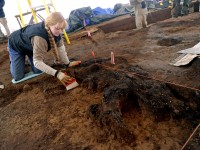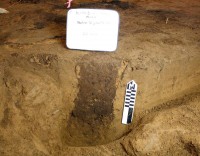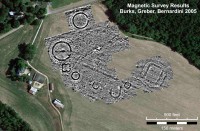 In 2008, a small mound on North Bridge Street in Chillicothe, Ohio, was bulldozed by commercial developers. There was no archaeological survey of the site, despite Ohio’s rich history of ancient Native American mounds, because sadly there are no laws even slowing people down from destroying ancient remains on private property. Whatever development plans were in the works in 2008 never came to fruition and the property lay fallow until this year.
In 2008, a small mound on North Bridge Street in Chillicothe, Ohio, was bulldozed by commercial developers. There was no archaeological survey of the site, despite Ohio’s rich history of ancient Native American mounds, because sadly there are no laws even slowing people down from destroying ancient remains on private property. Whatever development plans were in the works in 2008 never came to fruition and the property lay fallow until this year.
A few weeks ago, Guernsey Crossing LLC began building a mall on the 13-acre site. This time people concerned about the late lamented mound reached out to archaeologist Dr. Jarrod Burks, president of the Heartland Earthworks Conservancy, who contacted the developers and struck up a deal: Burks and a team of volunteers would be given three weeks to excavate the site where the mound had once been. They started out with a magnetic survey of the site to identify the perimeter of the mound and the best areas to excavate.
After two weeks, they’ve found a cluster of burned bones that are most likely from a cremation, Burks said, and another set of unburned bones and teeth. In addition, after painstakingly and carefully feathering away the soil a few specks of dirt at a time, they’ve uncovered shards and pieces of prehistoric pottery and a great deal of burned wood that will be able to be dated by its carbonization.
Burks, whose paying job is with Ohio Valley Archaeology in Columbus, said the mound probably dates from between 200 B.C. to A.D. 200. Before flattening, it was about 2 1/2 feet high. The area is about 80 feet in diameter.
Archaeologists can’t tell if the burned bone fragments are human or animal, but the uncharred bone discovered next to the burned pieces are human, so it’s likely the burned ones are too. The pottery fragments are the source of the preliminary dating based on design and style.
Basically what’s left is a thin layer of the mound floor, still intact after bulldozing just below the surface. Floors may not sound glamorous, but they’re extremely important archaeologically speaking. These postholes are unusually large, one wide enough to hold a post six to eight inches in diameter. The hole seems to have been deliberately filled in after the post was removed, perhaps during the construction of the mound.
 That they’ve been able to find postholes is highly significant because they impart a great deal of information about the construction of the site, and since so many of Ohio’s ancient mounds were destroyed long before archaeological practices paid much attention to, well, holes, this little ex-mound may teach us new things about the architecture of these structures.
That they’ve been able to find postholes is highly significant because they impart a great deal of information about the construction of the site, and since so many of Ohio’s ancient mounds were destroyed long before archaeological practices paid much attention to, well, holes, this little ex-mound may teach us new things about the architecture of these structures.
The mound is going to be a mall parking lot soon, so the team has to clear out everything they find for further study. The Native American tribes would prefer that human remains not be disturbed, but unfortunately that’s not an option here. Burks is working with the developers to ensure the area isn’t entirely bereft of recognition of its ceremonial and historical importance.
While we’re on the subject of ancient Native American mounds in Chillicothe, things are going gangbusters at the Junction Group Hopewell Earthworks. After a frantic two-week period of fundraising last March, the earthworks, none of which are visible above ground but their foundations are still extant underground, were saved when heritage and ecological preservation non-profits including the Heartland Earthworks Conservancy and Arc of Appalachia rallied to raise funds to buy the archaeological and environmentally important parts of the Stark family farm. Almost 1,000 individual donations were raised in that fortnight of mad activity, enough to allow the coalition to buy 193 acres — earthworks, woodlands and a 1.25-miles stretch river corridor — at auction for $1.1 million.
 Most of that purchase price, 75% of it, came from a matching Clean Ohio Fund grant which wasn’t actually granted yet when they bought the land. Arc of Appalachia noted at the time that “we raised roughly $375,000 through the generosity of over 900 donors, funds which we will use to leverage a Clean Ohio grant to pay the remaining balance of acquisition funds needed.” They seemed confident but I was concerned about whether the grant was a sure enough thing to consider the Junction Group Earthworks well and truly saved.
Most of that purchase price, 75% of it, came from a matching Clean Ohio Fund grant which wasn’t actually granted yet when they bought the land. Arc of Appalachia noted at the time that “we raised roughly $375,000 through the generosity of over 900 donors, funds which we will use to leverage a Clean Ohio grant to pay the remaining balance of acquisition funds needed.” They seemed confident but I was concerned about whether the grant was a sure enough thing to consider the Junction Group Earthworks well and truly saved.
Well, I’m delighted to report that the Clean Ohio Fund matching grant came through and in July of last year, Arc of Appalachia Preserve System director Nancy Stranahan and Heartland Earthworks Conservancy director Bruce Lombardo officially closed on the property. They’re wasting no time on their goal of making the site a public park. The new Junction Earthworks Archaeological Park and Nature Preserve is slated to open this year, perhaps as early as this spring. There are tons of additional expenses involved in making it a proper park facility so donations are still very much open. Click here to donate to the Junction Earthworks Park Development Fund online.
Meanwhile, the same Jarrod Burks mentioned above, who happens to have done the first magnetic survey of the Junction Group site in 2005 which revealed that the foundations of the earthworks were was still left undergound, has returned to make a more detailed survey. The original scan covered about 15 acres and with a single hand-held magnetometer, produced relatively low density data. This scan is being done with a four-probe magnetometer on a rolling cart which will collect far higher density data over the same ground thereby identifying smaller features (cooking pits, burials, postholes) the first machine couldn’t detect, and will eventually cover the entire 89-acre field.
Dr. Burks began scanning in November and is still doing it whenever weather permits, which isn’t often this winter. They only had two weeks and three weekends to complete the project in 2005. Now that they own the land, they can afford to take their time. You can see Jarrod Burks at work with his neat four-magnetometer scanner in this aerial footage by drone photographer Tim Anderson. The enclosure ditches, which are not visible above ground, have been marked out by mowing the soybean stalks left after harvest.
[youtube=http://youtu.be/BSgWxdNxAU4&w=430]
Such excellent news on the Junction Group Hopewell Earthworks!
I hope that Bridge Street mound gets the best treatment possible considering it’s about to be some totally insignificant parking lot.
We need new laws to protect these sites. I was reading a history of my home county and the moundbuilding sites were described as “victims of the plow” which made me furious.